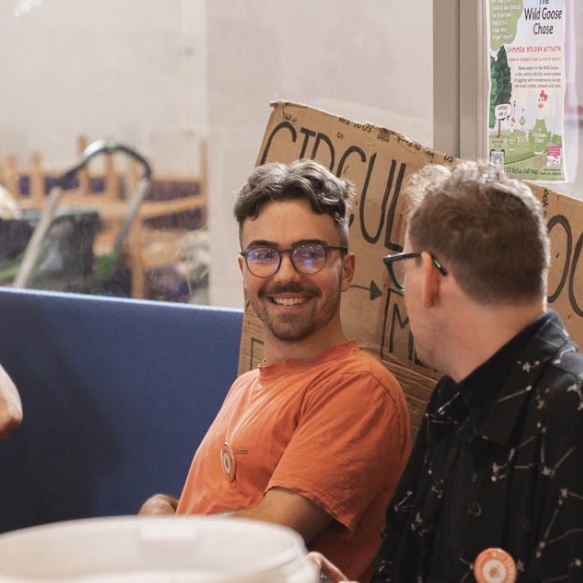Unlocking the Power of Living Compost: Three Ways to Regenerate Soil
- Alex Montgomery
- Apr 18
- 4 min read
Updated: Oct 13
At Generation Soil, we know that compost is more than just decomposed organic matter; it's a living, breathing community of microorganisms that connects everything in the food system. When made well, compost is alive with beneficial fungi, bacteria, protozoa, and other microscopic allies that work in harmony to build soil health, cycle nutrients, and support resilient plants from seed to harvest.

Our Living Compost is crafted using local food waste, wood shavings, biochar, and careful aerobic processing to cultivate a diverse and balanced microbiome. But how do you actually use this compost to get the most out of it?
Here are three powerful and practical ways to harness the regenerative magic of living compost:
1. Priming Seeds with Living Compost
Priming seeds means soaking or coating them before sowing to give them a head start. Most people use water or synthetic inoculants, but a simple Living Compost method can do much more. It adds biology, triggers natural defence systems, and helps seeds adapt to their future soil environment.

How to do it:
Make a compost extract (see method two below).
Soak your seeds in the liquid for 4–24 hours, depending on the seed type.
Drain and sow directly into soil or trays.
This method coats the seed with beneficial microbes before it even germinates, offering early protection against pathogens and encouraging a stronger root microbiome from the very beginning. For heritage veg, climate-resilient varieties, or any seeds you care about, this is a game-changer.
2. Compost Extraction for Soil AND Foliar Use
Compost extracts are different (and easier to make) from compost teas. While teas involve brewing compost in water, often with added sugars or aeration, an extract is a non-brewed liquid that simply washes the biology off the compost into water, making it immediately available and active. This avoids feeding unwanted organisms and keeps the process clean and simple.

Extraction method:
Mix 1 part living compost to 4–5 parts clean, chlorine-free water (rainwater is ideal).
Gently stir or agitate by hand for 5–10 minutes, avoiding blending or over-aerating.
Strain through a mesh or cloth.
You’ll be left with a golden-brown liquid that contains billions of microbes, ready to be applied to soil, seedlings, or even as a foliar spray on leaves.
When and where to use the extract:
Water seedlings at the transplant stage to reduce shock.
Apply to tired soil beds before planting.
Spray on plant leaves to introduce beneficial microbes that outcompete fungal pathogens.
Regular use of compost extract brings biology into the picture where it may be missing, especially in degraded urban soils, compacted plots, or after years of chemical inputs.
3. Direct Application to Soil or Planting Holes
Sometimes, the best way to use compost is the simplest: apply it directly to where plants need it most.
Our Living Compost is rich, earthy, and packed with visible fungal strands and fine aggregates. Applying it in small but strategic amounts allows you to inoculate your soil with beneficial organisms, build structure, and provide long-lasting benefits without needing massive quantities.
How to apply:
Add a handful into each planting hole when transplanting veg or trees.
Side-dress established plants with a thin layer around the root zone.
Mix into the top few inches of soil when prepping a bed.
Unlike conventional compost, which is primarily used for bulk organic matter or nutrients, Living Compost is biological. This means you don’t need a wheelbarrow-load to see results, even a few handfuls per square metre can radically shift the soil microbiology toward health and regeneration.
Why Biology Matters
What sets Generation Soil’s compost apart is its living nature. Most bagged or “hot” composts are inert, high in NPK but low in life. They feed the plant directly, which can lead to dependency and leaching. Living Compost works differently.

By feeding and seeding the soil’s natural ecosystem, you:
Improve nutrient cycling
Boost root development
Enhance disease resistance
Improve water retention
Support long-term soil regeneration
It’s not just about growing vegetables, it’s about growing soil.
A Living System, Not a Product
Living Compost is a relationship. When you use it, you’re introducing life into your food growing space. Whether you're priming seeds, extracting biology for liquid use, or planting directly into it, every step builds microbial bridges between compost, plants, and the wider ecosystem.
And the best part? You don’t need synthetic fertilisers, peat-based seed mixes, or chemical disease control. Nature already knows how to grow; we just have to support the system.
Want to Try It?
If you're in Bristol and part of a community garden, allotment group, or urban farm, get in touch about accessing our Living Compost. We offer it in small batches, designed for growers who want to work with soil biology instead of against it.
If you're interested in transforming your Bristol household or business food waste into living compost and having it delivered to your door, check out our Bristol Compost Project.
Generation Soil – Building fertility from the ground up, with microbes, food waste, and community power.



Comments